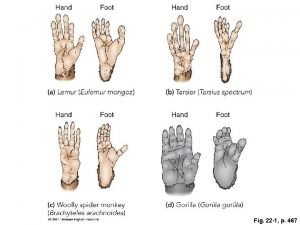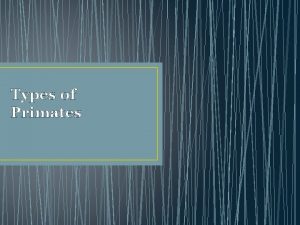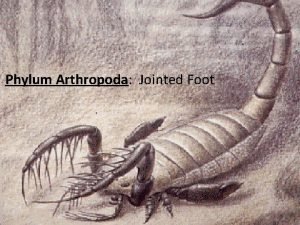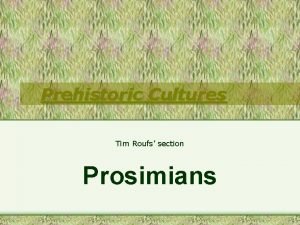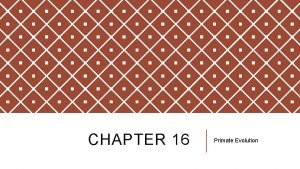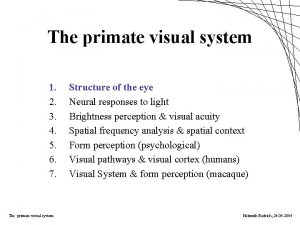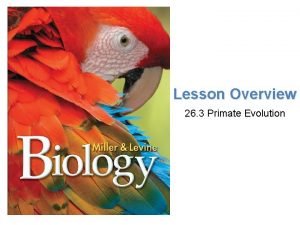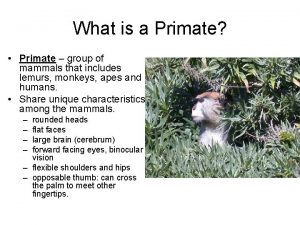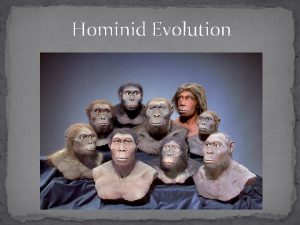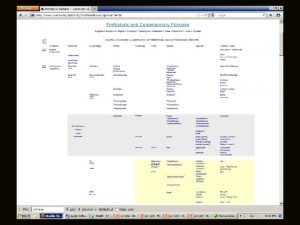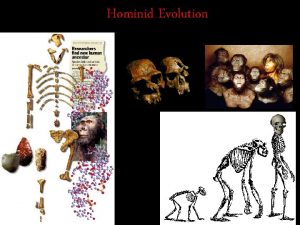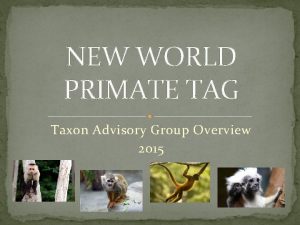Representatives of the Primate Group Prosimians q Prosimii





















- Slides: 21

Representatives of the Primate Group

Prosimians q. Prosimii means “before the monkeys”. q. This group includes the living lemurs, lorises and tarsiers, now found in some parts of Africa and Asia and Madagascar. q. Most prosimians living in areas other than Madagascar are nocturnal, or very shy, hidden creatures, because the monkeys are all active during the day they avoided competition.

Prosimians q. The dominant sense for the prosimians is scent. q. Many have special scent glands or mark their territory with urine, an exception being the tarsiers.

Tarsiers q These are the size of a rat, have enormous eyes and relatively long legs and large ears. q They are nocturnal and live in the trees. q They cling upright to branches and have an amazing ability to turn their heads 180 degrees to the right or left. q Their tales are long with a brush tip. q They are carnivorous, living on insects and small vertebrate prey.


Lemurs q. From the Latin word lemures meaning ghosts. q. Often hard to see in the trees. q. Range from a 12 cm mouse lemur to a 1 m tall Indri. q. The ring-tailed lemur has a dog-like face, a naked nose, furry ears, grasping hands and eats leaves, flowers and fruits.


Lorises q. These have adapted to a life similar to the sloth. q. By hardly moving they manage to escape detection. q. Sluggish, solitary and nocturnal, they feed largely on fruit, gum, insects, birds and birds’ eggs. q. They are found in south-east Asia and west Africa.


Monkeys q. About 30 million yrs ago, the ancestral primate line separated to form 2 families of Monkey. q. The dominant sense for monkeys in sight, so most are diurnal. q. They have good colour vision, allowing them to judge if fruit is ripe or leaves are fresh.

Monkeys q. They use colour as a method of communication. q. A very colourful group of animals.

New World Monkeys q Found in Central and South America and are all arboreal. q They have well-separated outward-facing nostrils. q They have larger brains than the prosimians, and long tails which in many groups are prehensile. q This enables them to hang onto branches while their hands are free to reach out to the outermost branches where most fruit grows.

New World Monkeys q. They range from the tiny Tamarins and Marmosets to the Howler Monkeys and include the Spider Monkey, Organ. Grinder’s Monkey and Capuchin.


Old World Monkeys q. These have nostrils which are close together and face downwards. q. They live in Africa and Asia. q. They have better thumb grip than the New World monkeys, but none of them has a prehensile tail. q. They are arboreal and ground dwelling.

Old World Monkeys q. The Colobus and Langur monkeys are primarily leaf-eaters and are typically arboreal. q. The baboons and Macaques are 4 -legged ground dwellers q. They have insensitive pads of tough skin on their rumps, these allow them to sleep or sit upright while wedged in the branches of trees.


Baboons q. Have powerful arms and legs of equal length, an arched tail, and long dog-like faces. q. The males have huge canines and dominant males have long manes. q. They show sexual dimorphism. q. A baboon troop is a highly organised group that fiercely defends the females and young.


Macaques q. These are widely spread. q. In Japan, there are some Macaques that live in the snow. q. One of these has learned to warm up in the winter by bathing in the hot volcanic springs nearby.

 Prosimii
Prosimii Prosimian primates
Prosimian primates Prosimians characteristics
Prosimians characteristics How many house of reps per state
How many house of reps per state Chapter 10 section 2 the house of representatives
Chapter 10 section 2 the house of representatives The senate and house of representatives
The senate and house of representatives The senate and house of representatives
The senate and house of representatives Congress gym
Congress gym The structure of congress lesson quiz 5-2
The structure of congress lesson quiz 5-2 How many representatives per state
How many representatives per state The senate and house of representatives
The senate and house of representatives Arthropoden definition
Arthropoden definition Primate taxonomy
Primate taxonomy Primate city
Primate city Homo primate
Homo primate Monica morgado
Monica morgado Chapter 16 primate evolution
Chapter 16 primate evolution Primate suite of traits
Primate suite of traits What is this
What is this Is mexico city a primate city
Is mexico city a primate city Primates evolved from
Primates evolved from Curve of wilson
Curve of wilson
